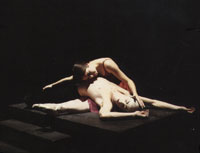
Choreography: Todd Bolender
Music: Bela Bartok
Set: Howard Jones
Costumes: Russ Vogler
Bela Bartok is indisputably the greatest composer of his country. His compositions are at once imbued with peasant culture and nationalistic fervor, and enormously significant in the development of twentieth century music. His expressive creativity is amply evident in The Miraculous Mandarin, written during a period of depression and personal despair following World War I. It is Bartok’s vision, of war and war’s ravages, which Todd Bolender sought to illuminate in the work, which he choreographed for the New York City Ballet in 1951, at the behest of Lincoln Kirstein. Earlier choreographers had most often elected an interpretation faithful to the work of the Mandarin’s first librettist, I.M. Lengyl, an interpretation bent toward pantomime. Mr. Bolender has dramatized the story’s universality, and timelessness, its indictment to man’s inhumanity, through movement which avoids the broad histrionics and pitfalls of pantomime.
The story is one of mean streets. A murderous gang of thieves ply their bloody trade in the scarred cityscape which has no name, assisted in their brutal aims by a wanton, cruel girl. It is she who procures, she who seduces, luring first one, then another, each to his death. She knows no regret, no remorse until she encounters the gentle Mandarin in whom she ignites a consuming passion that will not be still. He refuses to die until his love is satisfied. In the focal pas de deux, she is drawn to him, by the depth of his desire, but she cannot surrender, cannot let go for he distorted, stunted existence. She has known no other life.
At his death she is awakened, and grieves. The Miraculous Mandarin has been described by some observers as a “tragic, but cathartic story of primitive man’s desire and a corrupt woman’s purification of love…celebrated at last as the moment of death.” For others, the drama unfolds as an allegory of the despair of European intellectuals over the raping brutality of the First World War, and thus the Mandarin appears as a symbol of enlightenment and passionate commitment to justice and enduring peace.
“The theme … is set out by the choreographer in dance passages and scenes of emotional eloquence and stunning design,” wrote Walter Terry in a review of the New York City Ballet’s premiere on September 16, 1951. That eloquence and design are evident in the ballet opening as the Gang confronts the audience in a thrust of anger and accusation. Responsibility for their debasement, they insist, is ours. We must acknowledge our culpability, for they are society’s lurid detritus; their city, any city; their time, any time. From this arresting beginning to the tragic conclusion, the dance is informed by anger, spilled out in movements of rough angularity and violence. In Mr. Bolender’s telling, the tale is dramatic and allegorical, immediate and timeless. He has redefined the dramatic by invigorating and enlarging the role of the Girl; he has heightened the symbolic with the introduction of the Blind Girl, the slattern’s other self. Both are departures from the original libretto; both are intended to heighten the drama’s intensity, to add new layers of meaning.
In the New York City Ballet premiere, Melissa Hayden and Hugh Laing were the critically-acclaimed principals. In later performances, Mr. Bolender appeared as the Mandarin to equal and enduring acclaim. The piece received its Kansas City premiere by the company in 1985 and reveals itself again, this autumn, as one of the most stunning ballets in the State Ballet of Missouri’s repertoire.